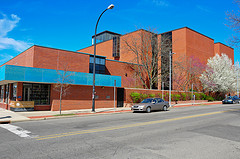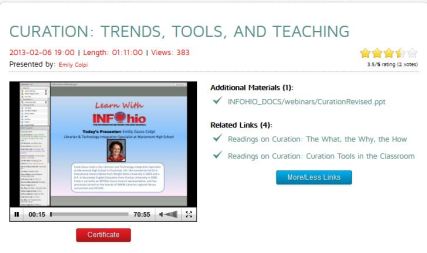This week’s readings were well suited to our last class. They all dealt with different ways in which we can continue our learning as professionals throughout our careers. While it may be disheartening that we will never know all that we need to in our jobs, it should also be exciting – a sign that the profession and world is constantly changing and that we have no reason to become bored.
“When Teachers Drive Their Learning” by Joseph Semadeni
This article describes a model of professional development for teachers, called Fusion, created by a rural school in Wyoming. Through Fusion, teachers can choose specific areas of interest (or in which they feel they need growth), learn about them during work hours, and then be rewarded when they demonstrate that they have used the knowledge gleaned from these studies. Some elements that I liked or found particularly interesting were:
- The school’s commitment to teachers’ professional development. Semadeni writes, “Teachers who choose not to participate in Fusion work with principals to develop their own plans for improving professionally” (66). This suggests that school really desires its teachers to continue to grow, most likely for the sake of not only the teachers but the students and school as a whole.
- Teachers have to do a reading-and-writing assignment about what they have learned. This sounded so much like something a student would have to do that I was once again reminded of how teachers must continue to learn as their pupils do.
- Upon successful demonstration of mastery of the practice that they learned, teachers can earn a financial reward. While it makes sense to use incentives to further motivate participation, I was not so familiar with monetary rewards for professional development. It certainly worked for Fusion (and I am sure it would work in other situations)!
“The C’s of Our Sea Change” by Helene Blowers and Lori Reed
This article addressed professional development in terms of continued learning about technology in a library. The Public Library of Charlotte & Mecklenburg County implemented a program called Learning 2.0 for this purpose. Once again, I would like to point out a couple parts of the article that struck me:
- Staff were encouraged to play around with the different Web 2.0 tools. This reminded me a lot of class where we got to test out various tools, especially when we went together over how to use Blackboard Collaborate and, earlier in the semester, when we had to produce a visualization of a question we had from the readings. Not only was this a great way to discover various features of the tool, but it also helped to build confidence.
- Once again, I bring up confidence – perhaps because this is an area in which I know I need more work! The article mentions that participants began to experiment and play around more with the tools as they became more comfortable and confident with them. For me, class has had the same effect. As I have tried out Twitter, webinars, screencasts, blogging, etc., I have gotten over some of my technophobia and feel more excited about trying other tools and kinds of social media in the future.
“Planning an Online Professional Development Module” by Kristin Fontichiaro
This article discusses implementing the aforementioned Learning 2.0 model into an elementary school setting. Below are the points I found the most interesting:
- In blogging about the tools, participants were specifically asked to think about how they might be useful or not useful in their lives, personal or professional. Then, they had to consider the tools and how they might be used in the classroom, including any surrounding issues. This reflection is important to make sure that the person is not just using the tool but considering its potential implications, including possible problems.
- Like the previous article, unofficial teamwork resulted and feelings of community developed. Even the first article by Semadeni mentions a sense of reciprocal learning. It is wonderful to know that professional development can move beyond a personal endeavor to a cooperative effort that is beneficial for all involved.
- The article ended with a call for others to join in this project. I should consider this in the future: you can call out to other organizations and individuals to join once you have a system fairly well established so that you have something to offer other institutions as incentive and can learn more from them by increasing the number and variety of participants.
I mentioned in the beginning that the fact that we always have to learn more is both disheartening and exciting. It is also comforting because we can know when we are starting out that we are not the only ones who have to learn more. We must all continue to seek out education. By doing so, we not only strengthen ourselves and our institution but also our profession, better assisting our patrons and showing that there really is a lot of knowledge necessary in the job of a librarian.
Works Cited
Blowers, Helene, and Lori Reed. “The C’s of Our Sea Change: Plans for Training Staff, from Core Competencies to Learning 2.0.” Computers in Libraries 27.2 (2007): 10-15.
Fontichiaro, Kristin. “Planning an Online Professional Development Module.” School Library Media Activities Monthly 25.2 (2008): 30-31.
Semadeni, Joseph. “When Teachers Drive Their Learning.” Educational Leadership 67.8 (2010): 66-69.



